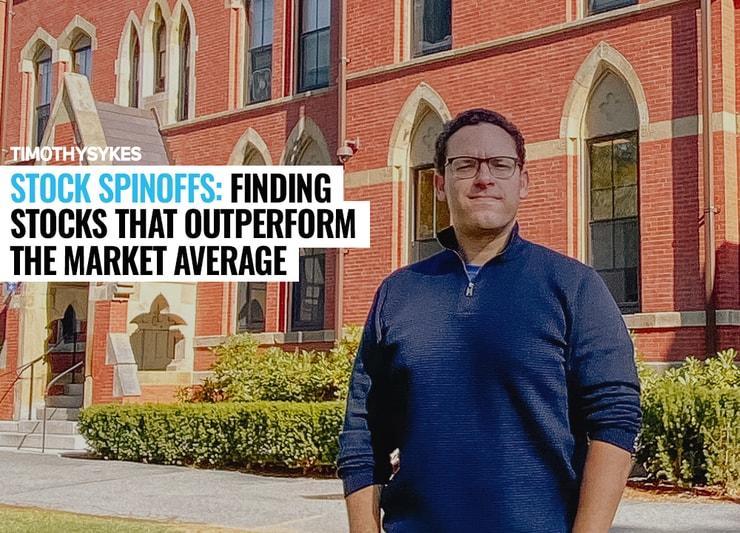It seems almost every trader, at some point, searches for that magical, mystical, free-lunch kind of trade …
Unfortunately, just like unicorns, there’s no such thing as a free lunch. But there is a certain type of investment that historically beats the market every year.
What is it? Stock spinoffs and variations.
When certain criteria are met, these breakaways see an average return roughly 10% higher than the rest of the market.
Now, a word of caution from your friendly penny stock day trader: Nothing is a sure thing. Recently the market is just as brutal to spinoffs as it is to other companies.
Also, this is not a fast in-and-out play. Most positive price action from spinoffs happens a few months after the subsidiary becomes its own company.
Let’s take a look at how this works so you can make an informed decision about spinoffs.
Table of Contents
What Are Stock Spinoffs?
A spinoff is the creation of a new, independent company from a division of a parent company.
The parent company either sells or distributes shares of the new company — hence the term stock spinoff. Shareholders in the parent company are given shares in the new company on a pro rata basis.
Benefits of a Stock Spinoff
There are a few reasons why the parent company might want to form a new company, but in the end, it’s about creating more value for shareholders.
The division being spun off might be underperforming or outperforming the core business. Or the spinoff may be moving in a different direction or be a very different type of business in relation to growth and risk.
One way to analyze the benefits of a spinoff is to view it from a mergers-and-acquisitions perspective.
When companies merge, the C Suite and board of directors usually give reasons involving economies of scale and synergy. It’s believed that combining the two companies will create more value for shareholders.
While a spinoff seems to go against this, it’s not always the case. Sometimes these big conglomerates become sluggish, losing their sense of agility. Sometimes the synergy just plain doesn’t work out or economies of scale never materialize.
At that point, the merger starts to look bad for both companies … so the parent company spins off the subsidiary.
Other times, the parent company may have grown into several unrelated business divisions. Then a spinoff makes sense for both the subsidiary and the parent company.
Maybe different divisions have different growth outlooks or different levels of risk. A stock spinoff allows each company’s management to focus on its core business.
Benefits of the Stock Spinoff for the Parent Company

2025 Millionaire Media, LLCFor the parent company, the benefits are based on either business optimization or a political agenda.
In the case of politics, a company might pursue a spinoff to avoid regulatory pressures in a specific geographical area.
And if the parent company spins off the subsidiary for business optimization, it could be for several reasons. Here are just a few:
- Shedding an underperforming part of the business.
- Releasing a strong performing division to create more value for shareholders.
- A return to the core business.
- A desire to focus on fewer geographical areas.
One interesting thing to note here:
Many spinoffs result in the subsidiary taking on corporate debt. This can improve the parent company’s fundamentals in the quarter following the stock spinoff.
It seems like burdening the subsidiary with ‘toxic debt’ would be bad for the new company — but that’s not always the case. Sometimes it can even help with initial downward pressure on the stock, giving you a better idea of when to enter your position.
Benefits of the Stock Spinoff for the Subsidiary
The spinoff can also see a number of benefits …
- The freedom to operate in line with core business strategies.
- The agility to open new markets.
- Separating from a parent company that’s not performing as well.
- Room for the new company’s management to maneuver without worrying about the parent company.
Also, if there are regulatory issues, the parent (or subsidiary) can operate free of these pressures.
Let’s look at a speculative example:
Say Amazon were to spinoff its cloud-based web services division (AWS) from its e-commerce platform. Why? To avoid regulatory issues with the federal government.
(Note: This hasn’t happened, but it has been discussed by analysts.)
For shareholders, a spinoff means the stock they own becomes what’s called a pure play business. After the spinoff, they own shares in two companies — each focused on their core business in one industry or market sector.
There’s less muddying of the waters like you might see with some corporate behemoths.
When the spinoff happens, shareholders are given shares in the new company on a pro rata basis. Each company is owned by the same stockholders in the same proportion as the parent company.
Sometimes shareholders have a choice about whether they take part in the spinoff, but most of the time, they receive shares of the spinoff as a type of dividend.
There’s an interesting phenomenon that occurs when a conglomerate spins off a subsidiary.
First, there’s downward pressure on the price. That happens for a few reasons, and it’s important you understand them …
The first reason has to do with institutional investors. Many institutional investors hold a certain dollar amount of each stock in their fund.
Here’s an example: Say Fund X owns $10 million worth of 10 different companies. One of the companies, Company C, decides to spinoff a subsidiary into Company S.
When Company S is formed, Fund X now owns a stake in both Company C and Company S. But owning Company S doesn’t make sense for Fund X.
Maybe the stake is too small. Maybe the spun-off company no longer matches the industry sector of Fund X … Whatever the reason, Fund X sells its entire stake in Company S.
Let’s look a the second reason for downward pressure:
Individual investors often sell their newly spun stock right away — just like the institutional investors. Maybe the new company doesn’t meet their investment criteria or they want to invest the proceeds back into the parent company.
It’s fairly common.
When both institutional investors and individual investors attempt to sell at the same time, supply outstrips demand. So what happens next?
If you guessed the price goes down, you’re right. All that selling creates downward price pressure that has nothing to do with the actual value of Company S stock.
So why doesn’t Company S try to promote its newly trading stock to keep the price up? Because many of the stakeholders in Company S are waiting for their share distribution as part of the spinoff. They benefit from being offered undervalued shares.
So they keep their collective lips zipped and wait for the market to catch up with the fundamentals. And they reap a nice profit along the way.
It also gives them a huge incentive to make the spinoff profitable. When the stock goes up, their executive compensation packages get bigger.
What Is the Difference Between a Spinoff and a Split-off?

2025 Millionaire Media, LLCBoth sinoffs and split-offs are a form of divestment or divestiture. Divestment is the opposite of investment and involves a company selling assets. When a parent company sells off a business division to create a new company, it’s a form of divestiture.
In a spinoff, every shareholder is given a share distribution in the new company — like a dividend.
On the day of the spinoff, the value of the shares they hold is the same as owning shares in the parent company before the spinoff.
FOR EXAMPLE: Let’s say Big Fast Company decides to spin off its sports car division. Shares in Big Fast Company go for $50 on the day of the spinoff. The spun-off company will be valued in such a way that its shares will be worth $10 each.
On the day of the spinoff, shareholders own two different stocks. For every share of Big Fast Company they owned before the spinoff, they now own one share of Big Fast Company and one share of Fast and Furious Super Cars.
The combined value of the two shares would still equal $50 at market open …
If Fast and Furious Super Cars opens at $10, then Big Fast Company opens at $40. This is a simplified example, but you get the idea.
There are variations on how the stock is issued. Sometimes shareholders get cash plus a percent of a share of the new stock for each parent company share they own.
If you’re going to play a stock spinoff as a trader, you want to know its exact details: What do you get in exchange for owning the parent company shares when the spinoff occurs?
It’s all part of your research and due diligence. But, of course, you research every trade in depth, right?
In a split-off, shareholders have to exchange shares of the parent company for shares of the new company.
A key difference is how the subsidiary is valued in a split-off. That’s because the subsidiary shares are offered as part of an initial public offering (IPO) through what’s known as a carve-out.
Only after the IPO, when the market determines the value of the new stock, does the stock split-off involve shareholders of the parent company.
How to Find Great Stock Spinoff Opportunities

2025 Millionaire Media, LLCNot all spinoffs are created equal …
As a group, these stocks outperform the market. Individual spinoffs can dramatically outperform the market.
But the new company could also struggle and even go bankrupt. While stock spinoff investing is somewhat popular, some 38% of stock spinoffs don’t generate shareholder value in the first year.
So before you jump in and buy just any old stock spinoff, do your research. Many traders and investors who look at this kind of play don’t bother the Form 10 filing or other company financial information.
You can do yourself a big favor — and create a big advantage — by doing in-depth research.
Just like any type of trading or investing, you can lose money if things go wrong. Here are a few things to consider as you research and plan …
More Breaking News
- SoundHound AI Stock Slide: Investors on Alert?
- UBS Raises American Airlines’ Price Target Amid Optimism
- TMC Stock Surges: Significant Upgrades and Investments Propel Growth
#1 Pay Attention to News Catalysts
You already pay attention to news catalysts anyway, right?
A strong catalyst is one of my fundamental requirements when it comes to trading a stock. If you plan to play spinoffs, you need to understand not just the news but the cycle of news around the spinoff.
There are a few websites dedicated to spinoff news and information. Stock Spinoffs is a good place to start. It contains a list of stock spinoffs and information such as the parent company name, the spinoff name, and the expected spinoff date.
There’s also a section on the website for recent spinoffs. Like trading penny stocks, studying history can give you good insight when it comes to trading spinoffs.
Note how the price action of the parent company’s shares is affected by the announcement of the spinoff.
As you check out the news, here are a few questions to consider:
- What’s the reason for the spinoff?
- Will the new company be assigned toxic debt — i.e., is the parent company unloading debt? This isn’t necessarily a bad thing, but it can affect the share price and future price action for both companies.
- Is the new company big enough that institutional investors will remain players? Most of the time it’s better if the institutional investors sell the subsidiary shares. This creates downward pressure on the stock price right after the spinoff.
- Is there insider incentive reported on the Form 10 filing (the form submitted to announce the spinoff)? This is found in the executive compensation section and will give you the number of reserved shares for management and employees.
#2 Use Fundamental Analysis Software
As you research spinoff trades, it’s important to understand why each stock is valued the way it is after the spinoff. It can get fairly complicated if the parent company retains shares of the new company.
Sometimes I downplay company fundamentals in my style of trading.
But when it comes to spinoffs, fundamentals can be crucial — don’t overlook this. You need to understand the valuation of the new stock (or the parent stock). It’s one of the best ways to determine the chances of the stock price going up.
By setting up screens and adding spinoff stocks to your watchlist, you’ll be better able to determine the right entry and exit points for the trade. (Here’s how to develop a trading plan.)
It’s also important to understand why spinoffs historically outperform the market by about 10% …
It’s all in the numbers. Fundamental analysis is where you get the data you need to determine fair value for a spinoff company.
StocksToTrade is like my special weapon. I use it every single day to screen stocks that fit my criteria and the patterns I trade.
It can be used to search for news about spinoffs, as well. Plus, you can see how past stock spinoffs behaved, their chart patterns, and which spinoffs have proved successful.
#3 Follow Key Chart Patterns
I go on about patterns all the time, right?
Guess what … they matter here, too. As you research spinoff trades, take note of chart patterns for the companies involved. While nothing is guaranteed and this isn’t an exact science, historical charts give you an idea of what to look for in upcoming spinoffs.
Also, as an active trader, you might look for contrarian chart patterns. What do I mean by that?
Check it out: Most traders do a little reading and think they know a lot about stock spinoffs. What do they know? They know that spinoffs, as an aggregate, outperform the market.
But as I mentioned earlier, nearly 40% don’t show positive returns in the first year.
How can you take advantage of that? Is it possible downward pressure on a spinoff could be a short play?
Remember, your goal is to be the winner in as many trades as possible. Look for patterns.
Examples of Recent Stock Spinoffs

2025 Millionaire Media, LLCNetgear (Nasdaq: NTGR) just completed a spinoff of Arlo Technologies (Nasdaq: ARLO) after 20% of the company was offered as an IPO in August.
The remaining shares of Arlo were distributed to Netgear shareholders on December 31, 2018.
Arlo manufactures wireless, smart networked devices such as security cameras and lights. They also manufacture accessories such as mounting hardware, camouflage skins, and matching doorbells.
So far, this spinoff hasn’t done great. The initial stock offering of Arlo was $16 per share. The stock moved up to $22.60 in late August but has since fallen steadily.
It’s hovering in the $10 per share range during December and into 2019. While the S&P 500 is down 11.63% in that same period, Arlo has dropped 54.21%.
Like I said, there’s often downward price pressure on a new spinoff. So, is this the time to buy? A lot of analysts seem to think so. But do your own research first!
Here’s another example of a recently completed spinoff: Garrett (Nasdaq: GTX) — an automotive business specializing in turbocharger systems — from Honeywell (Nasdaq: HON).
Check out the Honeywell/Garrett spinoff prospectus to better understand how a stock spinoff works. If you’re serious about trading spinoffs you need to be able to read one of these!
Key Stock Spinoff Tips for Beginners
Don’t Put Your Trust in Stock Promoters
Remember, stock promoters get paid to market specific stocks. When you read a press release from a promoter, it contains all the possible positives and unicorn-level upsides to owning shares.
Don’t be fooled.
Do your research. Know your trade parameters. Stick to your plan.
I’m not saying you shouldn’t check out a stock that’s being promoted. If nothing else, it will teach you how pump and dumps work and how promoters con the average newbie.
Promoters are no different when it comes to stock spinoffs. Get on a few message boards or email lists and you’ll soon see how ‘spinoff X will make you a fortune.’
Educate yourself. Study every day (including weekends), and you’ll learn to separate the nonsense from the real news.
Don’t Trade too Big
Let’s say you do your research and you decide to play a stock spinoff.
Should you go for it and risk a huge percentage of your account?
Personally, I wouldn’t. Especially if this is a new play for you.
I have a few reasons for this …
First, stock spinoffs tend to be a little longer play. As I said before, the stock often has downward pressure in the beginning before bouncing back a few months later. Some investors only use stock spinoffs as a long-term buy-and-hold strategy.
Second, as a day trader, if I put a large percentage of my account into a stock spinoff, I could tie up money normally available to trade for a long period. This just doesn’t fit my trading strategy.
Never Stop Learning
The idea of stock spinoffs is pretty intriguing …
It can open up a whole new opportunity as a trading strategy. But you’ll need to study like crazy to be on the right side of this play most of the time.
Where can you get the in-depth trading knowledge necessary to increase your chance of success?
Simple: Join the Trading Challenge.
Be prepared … This is likely to be the most intense period of studying of your entire life. Not everyone is cut out for it. But if you put in the effort, you can potentially learn a set of skills that can serve you for life.
It won’t be easy. As a matter of fact, it’s gonna be hard.
But in my opinion, it’s worth it. You game?
The Bottom Line
Historically, stock spinoffs deliver strong returns relative to the market as a whole.
Spinoffs can be a good place to pick up undervalued shares. That is, as long as you have the patience to wait for the separated companies to thrive on their freedom.
Whether it fits your strategy … that’s entirely up to you and your goals.
Remember: Whatever you do, you need to educate yourself. Study like crazy!
Are you a trader? Have you used stock spinoff trading as a strategy? Let me know in the comments below how it worked for you. Newbie? Does the idea of spinoff trading appeal to you? Tell me about it below … I love to hear from you!










Leave a reply